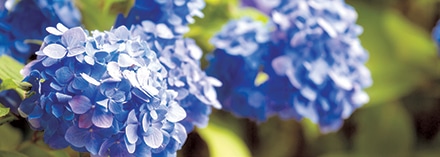
They are also used in flower arrangements. More than 500 varieties are available in the nursery trade, and they can be divided into two types. The Hortensia hydrangeas have large snow-ball-like blooms. The flat lace caps have their blooms in an outer ring of large flowers and a mass of tiny fertile ones on the inside.
Bigleaf hydrangeas are deciduous shrubs and have a rapid growth rate reaching several feet in height. They should be planted in a partly shaded area. The plants prefer a couple of hours of early morning sun but are unable to tolerate hot, dry sites that receive the full afternoon sun. However, avoid deep shade since they require at least three to four hours of morning sunlight daily. Excessive shade will reduce their production of flowers.
Hydrangeas do not perform well in our heavy clay soils. Add 50 pounds per 10 square feet of organic matter such as peat moss, topsoil, or compost to the soil in the area where they are to be planted. The clay soil will be loosened which will help improve aeration and drainage as well as helping retain nutrients and water. Dig the hole the depth of the rootball and at least twice as wide. When planting, make sure the crown of the plant is level with the top of the hole and no deeper. Avoid fertilization until the plant is established, around four to eight weeks after transplanting. During the growing season, apply a general purpose fertilizer, such as 10-10-10, in March, May, and July.
The bigleaf hydrangea has shallow roots and a high water requirement. It should be planted in moderate water-use landscape zones. Excessively dry conditions will cause them to wilt, so the soil needs to be kept evenly moist. Prune other shoots as necessary to encourage branching and fullness and do by August 1st. The new buds will begin forming in late summer for the following year. This action will encourage more vegetative growth at the expense of flowers but will be beneficial for the overall health of the plant.
Sometimes the plants fail to bloom. The cause is most likely freeze damage, the application of excessive nitrogen fertilizer, or pruning at the wrong time of the year.The level of aluminum compounds in the plants is the mechanism that determines the flower color. Higher levels of aluminum cause the flowers to be a dark blue. The color is a light blue when only minimal quantities are present. If aluminum is absent, then flowers are pink. Soil pH has an indirect impact on flower color. It determines the level of aluminum available for plant absorption. At a pH of 5.0 or lower, aluminum is more soluble, and thus the roots can absorb more of it. At a pH of 7.0 or greater, aluminum levels decrease. If you want blue flowers, you can acidify the soil by adding ½ cup of wettable sulfur per 10 square feet. For pink flowers, apply one cup of dolomitic limestone per 10 square feet to raise the pH. It may take a year or more before color changes are observable.
Bigleaf hydrangeas are a worthy addition to the garden. If given the right growing conditions, the plants will put on a show with their colorful blooms.
Timothy Daly is an Agricultural and Natural Resource Extension Agent with UGA Extension Gwinnett. He can be contacted at 678-377-4011 or tdaly@uga.edu

